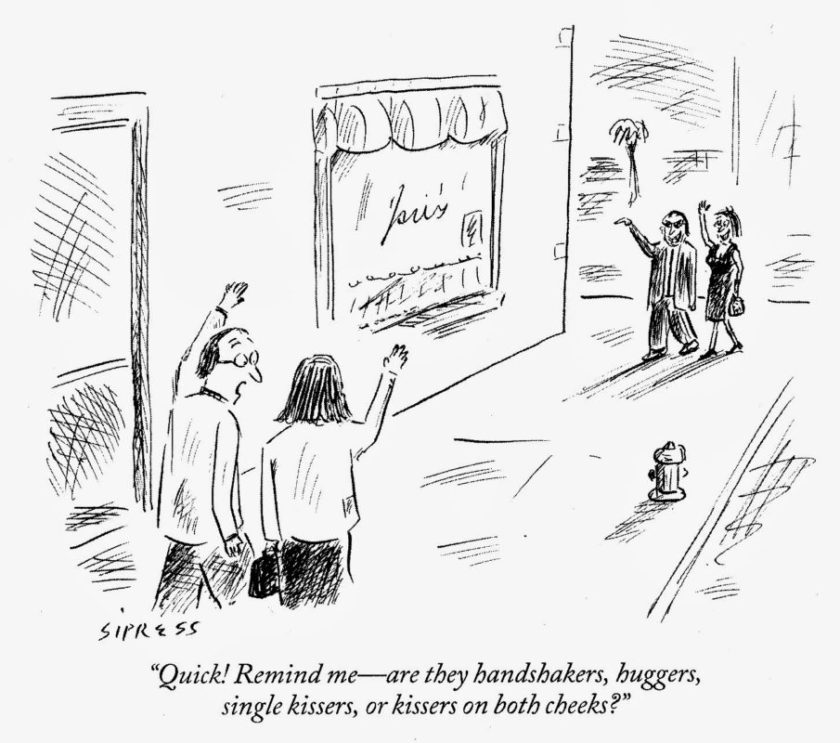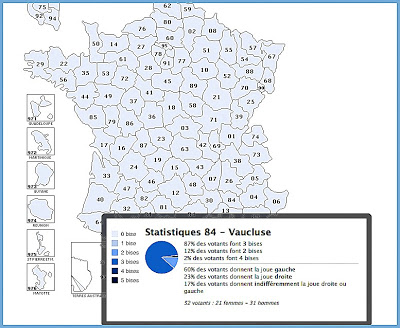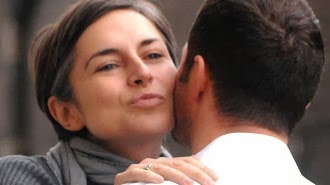
“Ah, the stress of meeting a French person,” an American friend once said to me. Remembering fondly her first trip to France, she said she landed in Paris where, after several weeks of introductions and various encounters with newly-made friends, she thought she had mastered the fine art of la bise…. And then, she traveled south to Provence where she discovered the salutatory kisses were not at all carried out in any predictable manner. Her confidence crumbled.
Is it one or two or even three kisses? Is it right-side first or left-side first?
For someone already struggling to remember how to say a few words in French—and whether to use tutoyer or vouvoyer forms—remembering comment faire la bise is enough to send one racing back to the ex-pat community.
It had been a while since I’d thought about this particular cultural difference. I have grown comfortable exchanging (usually) two kisses in Paris, commencing on… the right side, and three—even four—kisses in Provence, starting on the left side. However, I hasten to add that “usually” is the operative word and, most important in achieving success in the arena of la bise etiquette is honing one’s skills in observing people and copying them so as to go with the flow, as if it were all choreographed. A good sense of humor helps, too. But I am getting ahead of the story….
The “faire la bise” subject surfaced a few weeks ago when I met a French man with whom I had exchanged many emails and had had several telephone conversations. Upon meeting, I thrust out my hand to shake his at the same time he, I think, leaned forward to kiss cheeks, French style. I found myself a little embarrassed. We both laughed a little and at the end of the afternoon, exchanged bises in standard French style (two, right side first).
My rendez-vous reminded me that when and how to kiss cheeks, French style, would be a good topic to cover in a post. Alors, quand et comment faire la bise comme les Français. (That is, when and how to do the kiss like the French.)
In general, cheek-kissing (sometimes called “air kissing”) refers to lightly touching cheeks together while essentially kissing the air. This endearing, very French greeting usually takes place when French friends and family meet each other for the first time each day and usually at the end of the encounter and definitely at the end of the evening.
Kisses may also take place when you are first introduced to another person by a friend or family member. (Important to note that you don’t fait la bise with everyone to whom you are introduced; for example, not the fellow in produce section of the Hyper-U or a colleague to whom you are introduced in a business setting.) Kisses almost always take place when thanking someone for a gift or when congratulating someone. An exception to the aforementioned guidelines might surface when the other person is significantly older or holds an important position; in that case, a hand shake is usually the better course to follow (but with any luck, he or she will initiate one or the other actions and you can go with the flow).
In Lourmarin, a lovely Provençal village where I have spent a lot of time, mornings are abuzz with bises. As I sit at a table at Café Gaby, I might exchange a dozen kisses with those I know who pass by. And I watch the same scene repeat in the adjacent cafés. Men take off their hats and both men and women may take off their glasses (all in an effort to orchestrate this greeting with great aplomb…who would want to risk clanking glasses or knocking another’s hat off his head?). It seems that most people in Lourmarin start on the left side and tend to exchange three kisses.
However, good friend Pierre Schott reports that just 30 minutes north of Lourmarin, two kisses are typical. But, he quickly adds, “There are no rules—just take your cues from other people.”
To the east, in the Var Department of Provence, Pamela O’Neill said that two kisses are typical but, as for which side to start on, “I’ve been trying to figure that out since I moved here over ten years ago—there is no consensus, often making for awkward situations.”
Schott, who was born and raised in the Alsace Region of France, an area heavily influenced by its neighbor Germany, said that there, kisses are seldom exchanged outside of the cities in that region.
 |
| Click here to see how these two factors-number of kisses and which cheek to start on-vary across the Departments of France. |
There may be one rule shared by most French people: hugging is not generally part of their culture. Two men may grasp right hands and wrap their left arms around each other’s backs, but it is not the bear hug to which many Americans are accustomed.
I adore watching French children come into a room filled with adults. They may bashfully bow their heads upon introduction but deftly move from adult to adult kissing both cheeks of each person until they have covered the room. It is a charming scene.
Men may prefer shaking hands in some regions of France, but in Provence where I have made my most concerted observations, most men who are close friends would choose “faire la bise” (although shaking hands is perfectly fine).
A situation I have found particularly awkward is when you have developed the habit of shaking hands with someone and, as you have come to know that person, you feel that it might be time to graduate to bises (and tutoyer…a subject for another post!). You can always just ask, “On fait la bise?” (That doesn’t answer how many and which side though!)
In small villages like Lourmarin, where you may cross paths multiple times with the same person, one typically says something like “nous avons déjà fait les bises” and then waves. That is, “we have already done the kisses.” (Otherwise, the day could be consumed with exchanging all those bises.) Similarly, when one comes into, say a dinner party in a restaurant, there can be a lot of kissing to do before one can sit down to be served a cocktail; I’ve noticed that some folks may “throw kisses,” especially if it is difficult to make their way to everyone’s cheek!
When not feeling well, one usually declines to exchange les bises
, explaining that he or she is enrhumé. Or when it is really hot (as it is in July and August in Provence), one may skip les bises, but always with a brief explanation.
When two people say goodbye who know they won’t see each other for a long time, they may hold their cheeks together closer and longer than usual. I remember the first time Muriel said goodbye to me like this, an intimate gesture that continues to warm my heart.
Meeting a French person—or a person from any country—is a pleasure. It doesn’t matter whether you start with the left cheek and she starts with the right or you extend your hand and he extends his cheek. Whether you settle on a shake or a kiss (or two or three) and even if you knock noses in the process, make eye contact, smile, and convey to the person how really good it is to see him or her. That works in any culture.







Great article Susan! It's three kisses on our side of the Luberon too (Bonnieux).
Susan, you've nailed it again! I'll give you an on the spot report on the Languedoc …sometime this winter!
Well done, this! Wherever did you find that map! What a hoot!
Love this and I have been involved in a few akward moments…but not in France or even Europe. It was in Ecuador where I reached out to shake a gentleman's hand and he said no, no, no this is how we do it in Ecuador and he promptly kissed me on both cheeks…I later learned that Ecuadorians try to emulate the French in all aspects of life. Ecuadorians first choice in vacation destinations is Paris. Denise
Other cultures have their kissing rituals. Many, many years ago at a party in London I met a young lady from Poland. As we parted she held out her hand, palm down and fingers slightly curled. I shook her hand though that seemed rather awkward. As a result of this encounter I was invited to Poland. Not having my motorcycle insured for trips behind the iron curtain, I had to find another insurance company and lighted upon the splendidly named Baltic and Black Sea Insurance Company. At their office I waited for the agent, a very courtly gentleman, to finish with another client (a Polish lady) and noticed that as she left she held out her hand, palm down. Whereupon the agent, with a slight click of the heels, bent and kissed the back of her hand. This was such a nice gesture, involving not only a kiss but a bow, as a mark of respect. Subsequently, in Poland, I found this piece of knowledge as to what to do when a lady holds out her hand indispensable. Brian.
"Abuzz with bises…" What a perfectly lovely, bi-alliterative, onomatopoetic phrase! Very clever.
We had the same issue in Venezia – left first? Right first? Always two. I just wait for the other person's head to start veering in one direction before I start in!
Fun post, Susan! Thanks! ~ David
Once again, you hit the nail on the head. Yes, a sense of humor is mandatory, especially regarding the myriad humbling situations one encounters each day living here in Provence. Kind of like being a perpetual adolescent at a school dance. Awkward, embarrassed, but giving it a go with your best smile.
Hi Denise, That is so interesting about the Ecuadorian love of the French! It is fun to learn what other countries do to greet one another. Thanks so much for your note!
Thanks, Kathy…maybe we could do an observational study of Luberon greeting behavior. I wouldn't mind touring markets and sitting in cafes all day to record my observations!
Ever wonderdered whatever happened to "air kisses" ? After that lovely romantic blog, I couldn't get kisses off my mind. There were kisses, kisses everywhere flying through the air.
The air kisses simply didn't know where to land. Should it be the right cheek or the left ? Finally one day there was a big slip and one landed on the lip ! (Apparently he had NO savoir-faire!!).
I loved this article. I have been struggling with "faire la bise" Moroccan style. In Morocco, it's one kiss on the left and two on the right. Until I figured it out, my sequence on the exchange was always off.